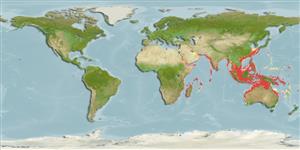Common names from other countries
>
Tetraodontiformes (Puffers and filefishes) >
Diodontidae (Porcupinefishes (burrfishes))
Etymology: Cyclichthys: Greek, kyklos = round + Greek, ichthys = fish (Ref. 45335).
More on author: Bloch.
Environment: milieu / climate zone / depth range / distribution range
Ökologie
seewasser riff-verbunden; tiefenbereich 9 - 170 m (Ref. 30573). Tropical; 32°N - 36°S, 24°E - 168°E
Indo-West Pacific: Red Sea and East Africa to the Philippines, north to southern Japan, south to Australia and New Caledonia (Ref. 9680). Southeast Atlantic: south coast of South Africa (Ref. 4423).
Size / Gewicht / Alter
Maturity: Lm ? range ? - ? cm
Max length : 30.0 cm TL Männchen/unbestimmt; (Ref. 9710)
Kurzbeschreibung
Morphologie | Morphometrie
Rückenflossenstacheln (insgesamt): 0; Rückenflossenweichstrahlen (insgesamt): 11-13; Afterflossenstacheln 0; Afterflossenweichstrahlen: 10 - 12. Adults brown to grey with blotches and clusters of black spots on back and sides; pelagic juveniles covered with black spots (Ref. 4423).
Inhabit clear protected reefs with sponge and algal habitats. Often in large sponges during the day (Ref. 48637). Usually over sand and mud bottoms to at least 170 m (Ref. 30573). Occasionally on reefs (Ref. 9680). Active at night, feeding among reefs (Ref. 48637). A nocturnal species (Ref. 9710) that presumably feeds on hard-shelled invertebrates (Ref. 9680, 48637).
Life cycle and mating behavior
Geschlechtsreife | Fortpflanzung | Ablaichen | Eier | Fecundity | Larven
Randall, J.E., G.R. Allen and R.C. Steene, 1990. Fishes of the Great Barrier Reef and Coral Sea. University of Hawaii Press, Honolulu, Hawaii. 506 p. (Ref. 2334)
IUCN Rote Liste Status (Ref. 130435)
CITES (Ref. 128078)
Not Evaluated
Bedrohung für Menschen
Harmless
Nutzung durch Menschen
Fischereien: kleinfischerei; Sportfisch: ja
Mehr Information
NamenSynonymeMetabolismusRäuberÖkotoxikologieFortpflanzungGeschlechtsreifeAblaichenFecundityEierEientwicklung
ReferenzenAquakulturAquakultur ProfilZuchtlinienGenetikElectrophoresesVererbbarkeitKrankheitenVerarbeitungMass conversion
Tools
Zusatzinformationen
Download XML
Internet Quellen
Estimates based on models
Preferred temperature (Ref.
115969): 22.3 - 28.3, mean 26.8 (based on 908 cells).
Phylogenetic diversity index (Ref.
82804): PD
50 = 0.6250 [Uniqueness, from 0.5 = low to 2.0 = high].
Bayesian length-weight: a=0.04786 (0.01967 - 0.11644), b=2.82 (2.61 - 3.03), in cm Total Length, based on LWR estimates for this (Sub)family-body shape (Ref.
93245).
Trophic level (Ref.
69278): 3.6 ±0.59 se; based on food items.
Widerstandsfähigkeit (Ref.
120179): hoch, Verdopplung der Population dauert weniger als 15 Monate. (Preliminary K or Fecundity.).
Fishing Vulnerability (Ref.
59153): Low vulnerability (20 of 100).
